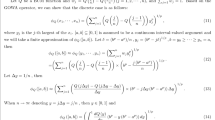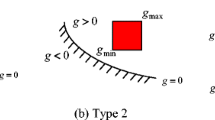Abstract
Reliability allocation is a crucial task in product design and development, directly influencing the quality and market competitiveness of a product. Traditional techniques for allocation of product reliability include the equalized allocation, ARINC, and AGREE allocation methods. Although these methods are simple and widely used in industry, they do not perform simultaneous allocation of the reliability of root and leaf nodes. Moreover, situations arise in the initial stages of product design in which there is incomplete information, increasing the difficulty of reliability allocation, can not be solved effectively using traditional reliability allocation methods. To resolve these issues, this paper integrates the ordered weighted averaging tree and soft set approach with regard to flexible allocation product reliability. To verify the proposed approach, a numerical example of a thin-film transistor liquid crystal display product is adopted. This paper also compares the results of the simulation with those of the equalized allocation, ARINC allocation, and AGREE allocation methods in dealing with incomplete information. The results demonstrate that the proposed method is more flexible and does not lose any valuable information that is provided by experts.


Similar content being viewed by others
References
Advisory Group of Reliability of Electronic Equipment (AGREE). (1957). Reliability of military electronic equipment. Washington, DC: Office of the Assistant Secretary of Defense Research and Engineering.
Ahn, B. S., & Choi, S. H. (2012). Aggregation of ordinal data using ordered weighted averaging operator weights. Annals of Operations Research, 201(1), 1–16.
Alven, W. H. (1964). Reliability engineering: Prepared by ARINC research corporation. Englewood Cliffs, NJ: Prentice Hall Inc.
Chang, K. H. (2009). Evaluate the orderings of risk for failure problems using a more general RPN methodology. Microelectronics Reliability, 49(12), 1586–1596.
Chang, K. H. (2014). A more general risk assessment methodology using soft sets based ranking technique. Soft Computing, 18(1), 169–183.
Chang, K. H., & Cheng, C. H. (2011). Evaluating the risk of failure using the fuzzy OWA and DEMATEL method. Journal of Intelligent Manufacturing, 22(2), 113–129.
Chang, K. H., Cheng, C. H., & Chang, Y. C. (2008). Reliability assessment of an aircraft propulsion system using IFS and OWA tree. Engineering Optimization, 40(10), 907–921.
Chang, Y. C., Chang, K. H., & Liaw, C. S. (2009). Innovative reliability allocation using the maximal entropy ordered weighted averaging method. Computers & Industrial Engineering, 57(4), 1274–1281.
Cheng, J., Zhou, F., & Yang, S. (2014). A reliability allocation model and application in designing a mine ventilation system. Iranian Journal of Science and Technology Transactions of Civil Engineering, 38(C1), 61–73.
Fuller, R., & Majlender, P. (2003). On obtaining minimal variability OWA operator weights. Fuzzy Sets and Systems, 136(2), 203–215.
Guo, H., Jiang, M., & Wang, W. (2014). A method for reliability allocation with confidence level. In Proceedings annual reliability and maintainability symposium, Colorado Springs (pp. 27–30). New York: IEEE.
Hu, Y. Z., Zhang, P. C., Su, Y. C., & Zou, Y. (2012). An optimal reliability allocation method for digital substation systems. In IEEE PES transmission and distribution conference and exposition, Orlando, FL (pp. 1–5). New York: IEEE.
Jun, Y. B., Song, S. Z., & Lee, K. J. (2013). The combination of soft sets and n-structures with applications. Journal of Applied Mathematics. doi:10.1155/2013/420312.
Kim, K. O., Yang, Y., & Zuo, M. J. (2013). A new reliability allocation weight for reducing the occurrence of severe failure effects. Reliability Engineering and System Safety, 117, 81–88.
Kuo, T. C., Huang, S. H., & Zhang, H. C. (2001). Design for manufacture and design for ‘x’: Concepts, applications, and perspectives. Computers & Industrial Engineering, 41(3), 241–260.
Lan, J. B., Sun, Q., Chen, Q. M., & Wang, Z. X. (2013). Group decision making based on induced uncertain linguistic OWA operators. Decision Support Systems, 55(1), 296–303.
Li, D., Sun, X. L., & McKinnon, K. (2005). An exact solution method for reliability optimization in complex systems. Annals of Operations Research, 133(1–4), 129–148.
Li, Z. W., & Xie, T. S. (2014). The relationship among soft sets, soft rough sets and topologies. Soft Computing, 18(4), 717–728.
Liaw, C. S., Chang, Y. C., Chang, K. H., & Chang, T. Y. (2011). ME-OWA based DEMATEL reliability apportionment method. Expert Systems with Applications, 38(8), 9713–9723.
Lin, J. T., Hong, I. H., Wu, C. H., & Wang, K. S. (2010). A model for batch available-to-promise in order fulfillment processes for TFT-LCD production chains. Computers & Industrial Engineering, 59(4), 720–729.
Ma, X. Q., Sulaiman, N., Qin, H. W., Herawan, T., & Zain, J. M. (2011). A new efficient normal parameter reduction algorithm of soft sets. Computers and Mathematics with Applications, 62(2), 588–598.
Mamat, R., Herawan, T., & Denis, M. M. (2013). MAR: Maximum attribute relative of soft set for clustering attribute selection. Knowledge-Based Systems, 52, 11–20.
Min, W. K. (2012). Similarity in soft set theory. Applied Mathematics Letters, 25(3), 310–314.
Molodtsov, D. (1999). Soft set theory first results. Computers and Mathematics with Applications, 37(4–5), 19–31.
O’Hagan, M. (1988). Aggregating template or rule antecedents in real-time expert systems with fuzzy set logic. In Proceedings of 22nd annual IEEE asilomar conference on signals, systems, computers, Pacific Grove, CA (pp. 681–689).
Sang, X. Z., & Liu, X. W. (2013). Parametric extension of the most preferred OWA operator and its application in search engine’s rank. Journal of Applied Mathematics. doi:10.1155/2013/273758.
Sriramdas, V., Chaturvedi, S. K., & Gargama, H. (2014). Fuzzy arithmetic based reliability allocation approach during early design and development. Expert Systems with Applications, 41(7), 3444–3449.
Tesfamariam, S., & Sadiq, R. (2008). Probabilistic risk analysis using ordered weighted averaging (OWA) operators. Stochastic Environmental Research and Risk Assessment, 22(1), 1–15.
Wang, S., Li, S., Zhou, J., Li, Q., & Kang, L. (2012). Reliability allocation for CNC machine based on improved fuzzy analytic hierarchy process. Advances in information Sciences and Service Sciences, 4(1), 320–327.
Wang, Y. B., Jia, X. S., Zhao, J. M., & Tian, Y. (2009). Improvement of agree allocation method. In Proceedings of 8th international conference on reliability, maintainability and safety (ICRMS 2009), Chengdu, China (pp. 293–295). IEEE, New York.
Wang, Y. M., & Parkan, C. (2005). A minimax disparity approach for obtaining OWA operator weights. Information Sciences, 175(1–2), 20–29.
Wei, C. F., Pei, Z., & Li, H. M. (2012). An induced OWA operator in coal mine safety evaluation. Journal of Computer and System Sciences, 78(4), 997–1005.
Wu, K. H., & Ye, S. C. (2014). An information security threat assessment model based on bayesian network and OWA operator. Applied Mathematics & Information Sciences, 8(2), 833–838.
Yager, R. R. (1988). On ordered weighted averaging aggregation operators in multi-criteria decision making. IEEE Transactions on Systems, Man and Cybernetics, 18(1), 183–190.
Yager, R. R. (2006). OWA trees and their role in security modeling using attack trees. Information Sciences, 176(20), 2933–2959.
Yang, Z. H., & Chen, Y. Z. (2013). Fuzzy soft set-based approach to prioritizing technical attributes in quality function deployment. Neural Computing and Applications, 23(7–8), 2493–2500.
Yuksel, S., Dizman, T., Yildizdan, G., & Sert, U. (2013). Application of soft sets to diagnose the prostate cancer risk. Journal of Inequalities and Applications. doi:10.1186/1029-242X-2013-229.
Zhang, Z. M., Wang, C., Tian, D. Z., & Li, K. (2014). A novel approach to interval-valued intuitionistic fuzzy soft set based decision making. Applied Mathematical Modelling, 38(4), 1255–1270.
Acknowledgments
The authors would like to thank the Ministry of Science and Technology of the Republic of China, for financially supporting this research under Contract No. MOST 103-2410-H-145-002 and MOST 104-2410-H-145-001.
Author information
Authors and Affiliations
Corresponding author
Rights and permissions
About this article
Cite this article
Chang, KH. A novel reliability allocation approach using the OWA tree and soft set. Ann Oper Res 244, 3–22 (2016). https://doi.org/10.1007/s10479-016-2178-4
Published:
Issue Date:
DOI: https://doi.org/10.1007/s10479-016-2178-4




